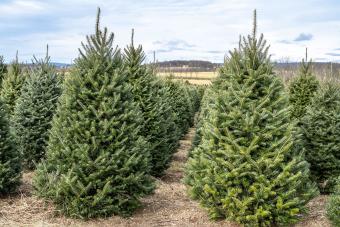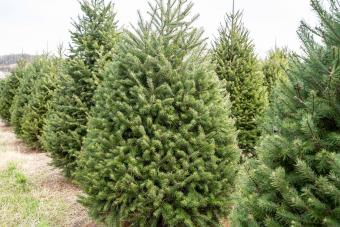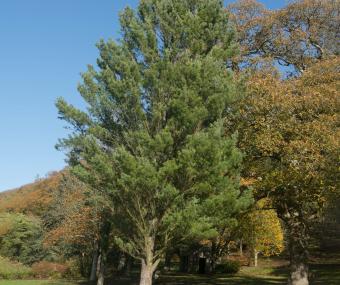
If you love the tradition of finding and maintaining a real Christmas tree, there are several options for which type of Christmas tree might work best for you. Shape, color, branch strength, and spacing between branches are all good things to keep in mind so that you get the perfect tree for your holiday decor.
Different Types of Christmas Trees
The three most preferred types of Christmas trees are firs, pines, and spruces, though there are a few less-common choices as well. Each type has its advantages and disadvantages, and some stay looking fresh longer than others.
Fraser Fir

Fraser firs are popular trees and definitely recommended if you have heavier ornaments; the branches of this tree are strong and have a more upright slant to them, so they hold heavy or long, dangling ornaments really well.
- Color: Medium green with a bit of a yellowish tint to the needles.
- Fragrance level: Fragrant, especially when you first bring into the house.
- Pros: Strong, well-spaced branches provide plenty of room for ornaments and other decorations.
- Cons: Fraser firs can be a little more expensive than other options due to their popularity and how long they last as a cut tree.
Balsam Fir

Balsam firs are everywhere during the holiday season. Their greens are popular used in wreaths and garlands, and they make wonderful Christmas trees as well.
- Color: Dark green
- Fragrance level: Highly fragrant with a clean evergreen scent.
- Pros: Strong branches for hanging ornaments, nicely spaced so that even larger ornaments fit well. They have a slightly narrower shape than other trees, so they work well in smaller spaces or corners.
- Cons: They can be among the pricier Christmas tree types to purchase due to their popularity.
Douglas Fir

Douglas fir trees have a pyramid shape that makes them wonderful for a nice open space, such as in front of a window. They're also very fragrant, filling your home with that perfect Christmasy scent.
- Color: Dougals firs are dark green.
- Fragrance level: These trees are well-known for their long-lasting, deep fragrance.
- Pros: Unlike other firs, which can be a little prickly to decorate, Douglas firs have softer needles that are a bit easier on the hands.
- Cons: The branches aren't as strong as those of other firs, so if you have a lot of heavy ornaments, this might not be a good fit. However, if you prefer using ribbon to decorate a Christmas tree, this might be the perfect choice. Douglas firs are also often the most expensive types of Christmas trees.
Scotch Pine

The Scotch pine (also sometimes called the Scots pine) is one of the most popular Christmas tree options. Its color, dense growth, and strong needle retention make this the top choice for many when choosing a Christmas tree type.
- Color: Scotch pines are a dark bluish-green to dark green.
- Fragrance level: Scotch pines have a medium-strong fragrance that fades somewhat the longer the tree is indoors.
- Pros: If you don't like having to clean up fallen needles (or have small children or pets who might try to eat them), this is a good option. If you have mostly smaller ornaments, this is a good choice because its branches are closer together, which will make your tree look fuller even with fewer ornaments. This is also one of the least expensive Christmas tree types.
- Cons: The needles can be quite prickly when decorating.
White Pine

White pines provide a soft, almost feathery look to your Christmas tree, with their long, slender needles and graceful appearance. What this tree provides in beauty, though, can be offset by some of its disadvantages.
- Color: White pines are a nice medium green tone. This is a good color if you have a lot of very colorful ornaments and want to have a nice backdrop for them.
- Fragrance level: White pines don't make very fragrant Christmas trees, and what scent they do have fades after a few days indoors.
- Pros: The soft needles are easy on the hands, and the feathery, soft appearance of the tree provides a nice backdrop for ornaments and other decorations. It also has nicely-spaced branches, which is good if you have a lot of larger ornaments. They're also usually fairly inexpensive trees.
- Cons: The branches bend easily, so if you have a lot of heavy ornaments, this might not be the best choice.
Blue Spruce

When many people picture a Christmas tree, they imagine a shape that looks pretty much exactly like a blue spruce, with its perfectly conical shape and generous branches. And if you love garlands and lots of ornaments, blue spruces are a good option, since they have plenty of multi-stemmed, strong branches.
- Color: Blue spruces have very pretty silvery-blue needles.
- Fragrance level: Blue spruces have a fairly strong fragrance that most people seem to appreciate. However, some people find the odor of them unpleasant (particularly true of the Colorado blue spruce), so this would be worth a little sniff-check when picking out the tree to make sure you're okay with the scent of it.
- Pros: If you have a lot of large or heavy ornaments, blue spruces are strong enough to hold them easily. Their growth habit ensures that you'll have plenty of branches to hang ornaments, garlands, and lights from.
- Cons: Blue spruces are often the most expensive Christmas tree types available.
Tips for Selecting the Best Christmas Tree
Once you know what type of Christmas tree will work best for you, make sure you're getting the freshest one possible by making sure it's not already dropping a large number of needles. Once you select your tree, trim about an inch of the trunk off of the bottom, and then get it into water as soon as possible so it will last the whole holiday season.







